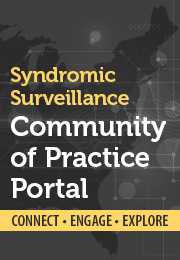BioSense Platform

Welcome! Here you will find information about the NSSP BioSense Platform. Better information leads to better decision making and public health actions.
Evolution of BioSense: Lessons Learned and Future Directions
Read about how the uses of syndromic surveillance have evolved from an early focus on alerts for bioterrorism-related illness to situational awareness and response on hazardous events and disease outbreaks. (PDF)
Features
CDC’s National Syndromic Surveillance Program (NSSP) BioSense Platform provides public health officials a common cloud-based health information system with standardized tools and procedures to rapidly collect, evaluate, share, and store information.
Health officials can use the BioSense Platform to analyze and exchange syndromic data—improving their common awareness of health threats over time and across regional boundaries. They can exchange information faster and better coordinate community actions to protect the public’s health.
The BioSense Platform was developed through an active collaboration of CDC and other federal agencies, state and local health departments, and public health partners. The platform hosts an array of user-selected tools and has features that are continually being enhanced to reflect their needs.
Operates in a Cloud Computing Environment
The NSSP’s BioSense Platform is the first Department of Health and Human Services system to move completely to a distributed cloud computing environment. Cloud computing gives participating health departments easily managed on-demand access to a shared pool of configurable computing resources. With distributed cloud computing, users control how they share data. By using common resources readily available on the BioSense Platform (e.g., networks, servers, software, tools, and storage), users have limited need for additional IT support. Users of the BioSense Platform benefit through efficiencies gained, cost reductions, and information-sharing capabilities.
Also, the BioSense Platform offers local and state users free secure data storage space, an easy-to-use data display dashboard, and, most importantly, a shared environment where they can collaborate and exchange knowledge of syndromic surveillance.
Allows Data Sharing across Jurisdictional Lines
The BioSense Platform hosts the only public health surveillance system that enables state and local health departments and CDC to share health information across city, county, or state jurisdictions.
The BioSense Platform provides the tools needed to aggregate syndromic data from healthcare organizations across the nation. And it allows health officials to put these data in context—for example, by allowing comparison of data from people obtaining healthcare to be analyzed along with other public health data sources (i.e., school and business absentee data, poison control reports, social media data).
Helps State and Local Health Departments Meet Meaningful Use Requirements
The tools hosted on the cloud-based BioSense Platform increase the capacity of state and local health departments to support Centers for Medicare and Medicaid Services Meaningful Use programs that expand the use of electronic health records. The BioSense Platform gives health departments a common electronic platform for collecting, storing, and sharing syndromic surveillance data, such as signs, symptoms and diagnoses of illness or injury. Syndromic surveillance is a system for collecting and analyzing medical data to validate and monitor harmful effects of exposures to diseases and hazardous conditions. Quick access to timely health data helps state and local health departments implement public health interventions faster.
NSSP supports a Community of Practice (CoP). The Syndromic Surveillance Community of Practice Portal links users of the BioSense Platform and others interested in syndromic surveillance with forums, a knowledge repository and training opportunities, NSSP and state resources, sign-on to the BioSense Platform, and more. The NSSP CoP enables those who conduct syndromic surveillance to connect with one another, participate in activities that advance both science and practice, and explore ways to integrate data from the BioSense Platform into a comprehensive surveillance program.
Tools
The BioSense Platform hosts integrated, standardized software tools shared across a cloud-based computing environment. You can collect data, analyze public health indicators, and, most importantly, share data and results. All tools are user-selected and tested. ESSENCE, developed by Johns Hopkins University (JHU), is the platform’s primary syndromic surveillance tool, and practitioners across the surveillance community have used variations of ESSENCE successfully for years. NSSP’s version of ESSENCE lets you collaborate with others across geopolitical boundaries to share data, which gives you a more accurate surveillance picture.
Tools hosted on the BioSense Platform:
- ESSENCE lets you capture, analyze, store, and share data. ESSENCE captures data in multiple formats, parses text strings into syndrome groups, and applies multiple detection algorithms. ESSENCE is designed for site administrators and users with a range of data analysis skills (from minimal to expert) but with a clear understanding of their site’s data.
- Adminer lets you view and do basic queries of MS SQL data stored on the BioSense Platform. Adminer is designed for site administrators with advanced SQL skills who want to get a quick peek at how the data flow and updates perform.
- Access & Management Center (AMC) is for assigning rights, access control, and data-sharing privileges to ESSENCE (and eventually other platform tools). Both users and site administrators may use the AMC, with site administrators having access to additional features that will help them facilitate how users share data.
- R Studio Professional lets you analyze data beyond what’s available through ESSENCE.
Other tools and data sources will be evaluated for inclusion on the BioSense Platform soon.
- Page last reviewed: September 20, 2017
- Page last updated: September 20, 2017
- Content source:




 ShareCompartir
ShareCompartir